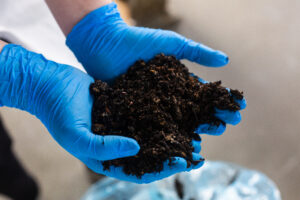Regenerative Agriculture: Agricultural Revolution or Carbon Pricing Capitalism?
Regenerative agriculture is about improving soil through better farm practices. The aim is to use farming practices that increase soil health through increased biodiversity, water retention, topsoil protection, and other farming process improvements. One key measure of healthy soil is carbon content. Therefore, a working carbon market for agricultural sequestration of carbon is a powerful lever to promote regenerative agricultural practices.
The scale of the opportunity is hard to quantify, as regenerative agriculture practices can be implemented in most agricultural verticals from aquaculture, forestry, livestock, to crops. As we are focusing on sequestered carbon and soil health, 11% of all land surface is used in crop production (3.7 billion acres). In the U.S. 254 million acres are farmed.
The Economics of Regenerative Agriculture are Changing
There is a reason why industrial-scale farms almost never use regenerative practices. It can be difficult and expensive to implement at scale, and the increased amount of management required does not always benefit from economies of scale in the same way as, say, mechanised row cropping or intensive livestock farming. This has ensured regenerative practices have usually, at least in developed agricultural systems, been implemented at small scales and to create premium products. However, two main drivers are making regenerative practices increasingly valuable; stewardship and carbon pricing.
Under the general term of stewardship, industries such as dairy and livestock are improving their environmental credentials. This is in reaction to; declining soil health, increasing input costs, consumer behavior change as demand for sustainably grown and farmed goods increases, and environmental scrutiny of practices such as fertilizer over-use. Regenerative agriculture is also gaining momentum as the 1% of produce that is grown under organic regulations in the US is increasingly mistrusted by consumers. Producers are looking for new ways to create premium products.
While stewardship adds value through improved soil health and consumer acceptance, creating a private carbon market for soil-sequestered carbon is an innovative financial lever that may incentivise the move away from extractive and intensive agricultural techniques. To understand the potential of making regenerative practices profitable, it’s useful to consider the Terraton Initiative.
Why is Indigo’s Terraton Initiative Important?
Indigo started as a microbiology company looking for ways to reduce biotic and abiotic stresses on the plant microbiome. The company has been able to provide yield increases in multiple crops (14% in cotton, 13% in wheat, 9% in soy, 6% in corn, 7% in rice) by adding beneficial plant microbes to seed coatings. The company, which was spun out as a project business from the innovation foundry Flagship Pioneering, has since built an ecosystem of products and services across the agricultural value chain from financing, agronomy and geospatial services (since acquiring TellusLabs in 2018) to storage and transportation solutions. Along the way, Indigo has raised over $600 million with estimated annual revenues of $500 million.
What is the Terraton Initiative?
Indigo is pricing each ton of carbon sequestered in soil at a fixed price of $15 dollars per ton. Growers earn credits for regenerative farming practices, and offsets can be purchased via Indigo Carbon at any point during the season. The company claims that its products can lead to increased CO2 sequestration of 2-3 tonnes per acre, giving a potential $30-$45 per acre boost to the farmer’s profits. Within a few weeks, farms equivalent to 3 million acres in size have already signed up to the initiative, meaning that Indigo has potentially created a carbon marketplace worth $90 to $135 million over the next growing season. Not a bad start.
What’s in it for Indigo?
For Indigo, this could increase their market penetration. The Initiative aligns with Indigo products which will be marketed as contributing to credits earned through Indigo Carbon. Furthermore, Indigo’s core business relies on understanding what is going on in the soil microbiome. This will give them greater reach and access to that data. This data will in turn help them train their agronomic data services, including providing corroborative ground data for its new geospatial operations. There are many potential wins for Indigo.
Competition
One start-up has already been working on a blockchain-based carbon credit marketplace for agricultural and atmospheric CO2 emissions for two years. Nori, a developer of a blockchain-based marketplace for removing CO2 from the atmosphere, just joined the Techstars Sustainability Accelerator. and Alexsandra Guerra from Nori will be joining us as a speaker at Cleantech Interactive on 17 June. The first Carbon Removal Certificates the company issued were generated from agricultural products that can store carbon dioxide in soils as the infrastructure to verify that carbon storage already exists.
What Other Innovation is Required to Promote Regenerative Agriculture?
Indigo, despite being one of the better placed companies to make soil measurements, with its combined offerings of in-field, data science, and geospatial technology, needs to seek soil carbon content verification from third party auditors to run this market. Measuring whether carbon is being sequestered in the soil will be critical to the market’s success. To do this work, innovation in soil sampling will be key. Potential solutions include:
- Trace Genomics, a developer of genomic and machine learning technology for soil sampling
- Rogo, a developer of an autonomous soil sampling robot
- Or perhaps even a diversification option for a company like Clear Labs, a developer of technologies and methods for rapidly analysing and indexing foods.
- To this end, Indigo just released this announcement: 5 August, 2019 – Indigo announces incubator to find technologies to quantify soil carbon content
There are also innovators tackling the introduction of regenerative practices using software:
- PastureMap, which has raised $3.2 million to-date, is developing grazing management and cattle record keeping software to promote regenerative practices in the livestock industry.
- Regen Network, arecent addition to the Techstars Sustainability Accelerator program being run with The Nature Conservancy, is developing an environmental assessment tool using blockchain and creating a marketplace for regenerative services.
- Soil Capital is a developer of an integrated environmental and economic dashboard for farmers to de-risk implementation of regenerative agriculture practices.
What Corporates are Adopting Regenerative Agriculture Practices?
Corporates are starting to react also. A recent example includes Danone’s announcement with partners including DSM, Yara, Corteva and start-up Connecterra, to coordinate 25 pilot projects across USA, EU and Russia to learn and share best regenerative practices in the dairy industry. Another is General Mills’ announcement that it would commit to regenerative practices in one million acres by 2030. While the company is taking a step in the right direction, 915 million acres in the US alone is classified as farmland, meaning this commitment will affect just 0.11% of US farmland.
There are investors who are calling out ‘regenerative’ as part of their investment thesis, such as Foodshots Global’s $10 million dedicated to supporting a ‘Soil 3.0’ paradigm, and we expect to see much more of this in the coming months.
How Can you Invest in a Set of ‘Best Practices’?
Adrian Rodrigues of Hyphae Partners, a firm working on developing and financing regenerative business models, argues that it is going to be challenging for traditional capital allocators to invest in this sector, primarily because you have to onboard the entire value chain to implement regenerative agriculture. One of the firm’s solutions is a blended finance structure that will deploy the type of capital that most suits each part of the value chain, stitching together a vertically integrated supply chain based on regenerative agriculture.
Keep an Eye on…
Regenerative practices in aquaculture. New York-based GreenWave are a good example of a company that focus on the restoration of ocean habitats not only as an end in itself but also to increase profitability from its farm. By introducing multiple species, including scallops, mussels, seaweed, oysters, and clams, within one farming ecosystem the farm creates its own nutrient cycle, provides a carbon an nitrogen sink, offers storm protection, and rebuilds marine ecosystems. Each of these protects the profitability of the farm itself.
What Market Trends are Shaping the Agriculture & Food Sector?
Our latest sector report explores:
- Recent advances in technology
- Innovative companies and their successes
- The deals defining a fast-changing sector.



